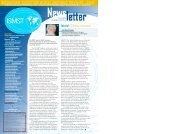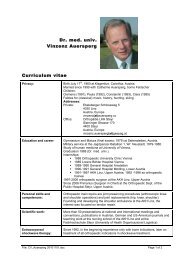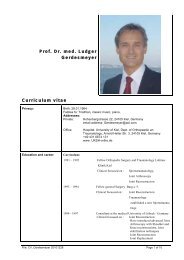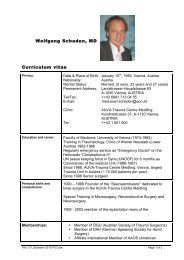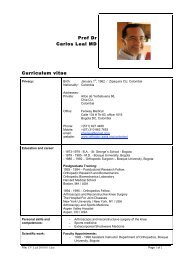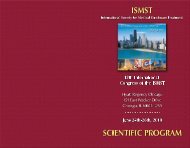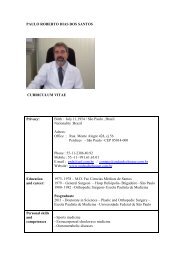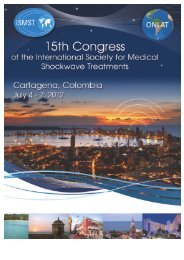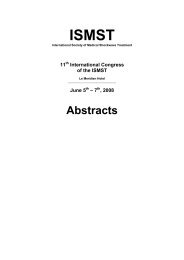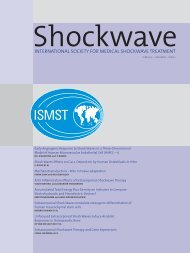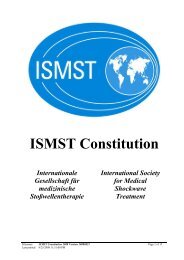Abstracts - ISMST - International Society for Medical Shockwave ...
Abstracts - ISMST - International Society for Medical Shockwave ...
Abstracts - ISMST - International Society for Medical Shockwave ...
Create successful ePaper yourself
Turn your PDF publications into a flip-book with our unique Google optimized e-Paper software.
<strong>Abstracts</strong><br />
Institution:<br />
Klinik für Orthopädie und Sportorthopädie, Klinikum rechts der Isar, TU München<br />
The aim of the present study was to investigate interactions of extracorporeal shock wave therapy (ESWT) with pathogenic<br />
bacteria.<br />
Direct effects of ESWT on bacterial growth were investigated with different pathogenic bacteria (Staphylococcus aureus,<br />
Staphylococcus epidermidis, Pseudomonas aeruginosa, Enterococcus faecium) in vitro. ESWT resulted in an energydependent<br />
reduction of bacterial viability, with significant inhibition of bacterial growth after increase of both energy flux<br />
density and impulse counts. Antibacterial effectiveness of ESWT proved dependent on treatment temperature and growth<br />
medium. ESWT per<strong>for</strong>med on bacteria suspended in growth medium at 35°C showed significantly reduced antibacterial<br />
effectiveness compared to ESWT at 20°C in normal saline. Low-energy ESWT on bacteria in tryptic soy broth at 35°C even<br />
resulted in stimulation of bacterial growth. Additional experiments per<strong>for</strong>med to reveal the antibacterial mechanisms of<br />
ESWT demonstrated energy-dependent increase of bacterial cell wall permeability, whereas damage of bacterial DNA was<br />
not observed. Synergistic effects of ESWT and additionally applied antibiotics could not be shown.<br />
Furthermore, safety and effectiveness of ESWT was investigated in chronic osteomyelitis in the rabbit. Chronic bone<br />
infections were established in the tibia 12 New Zealand White rabbits with S. aureus. Two interventions of planar ESWT<br />
were applied at 4 and 5 weeks after establishement of infection. Non-treated animals served as control. A significant<br />
reduction of soft tissue abscesses and reduced histopathologic infection score were observed in the ESWT group at study<br />
endpoint at 8 weeks. Furthermore, ESWT proved safe without postinterventionell bacteremia or sepsis. However, healing of<br />
the chronic bone infection did not occur.<br />
56. <strong>Shockwave</strong> Treatment <strong>for</strong> Orthopaedic Infections<br />
Richard Coombs, Moustafa Hafez, Milad Hanna,<br />
Nikki Horwood, Vipin Asopa<br />
Introduction: Initial experimental studies have been carried out to assess the potential <strong>for</strong> shockwave treatment eliminating<br />
bacterial infection. These studies have now been extended to include Gram-negative organisms.<br />
Methods: Twelve standardised pieces of lamb meat 7 x 5 x 5 cm were cut from fresh ovine leg muscle. Each piece was<br />
partially sliced across approximately 2 cm from the top. A 2 cm cube of muscle was cut from the centre of each sample<br />
and was discarded. A radio-opaque lead marker was placed at the bottom of each cavity and 1 ml of sterile liquid 1.2%<br />
Agar maintained at 42 °C was added to fill the cube completely. The top of each sample was then closed by covering with<br />
the partially cut slice of meat.<br />
Experimental samples were treated with shockwaves and were compared with untreated controls. All samples were diluted<br />
with brain heart infusion broth and counts of viable organisms were estimated after incubating the broth. Serial dilutions<br />
were used to assess the bacterial counts. The numbers of viable bacterial colonies were counted in the treated samples<br />
and were compared to the untreated controls.<br />
Results: In an initial ten samples there was a statistically significant kill rate <strong>for</strong> E.coli bacteria. Some changes were noted in<br />
the muscle tissue in the treated samples. This situation does not reflect the clinical condition. Part of the damage may be<br />
related to heat necrosis which would be reduced in the living patient with normal muscle blood flow. In the clinical situation,<br />
petechial haemorrhages and minor haematomas have been reported in the literature following the treatment of soft tissue<br />
problems with shockwaves.<br />
In our own clinical series of nearly 400 patients, we have so far not experienced this complication.<br />
Further experiments will be carried out with E-coli bacteria inserted into an intraosseous position. In addition, experiments<br />
will be carried out to assess the minimum level of shockwave energy which is required to have a significant effect on<br />
bacteria in the in vitro situation.<br />
Discussion: Initial studies have shown that shockwave treatment in an appropriate experimental model can kill up to 99%<br />
of bacteria. Additional studies have been carried out with Gram-positive organisms, specifically Staphylococci including<br />
MRSA and also fungi. These studies have now been extended to include Gram-negative organisms which are also killed by<br />
shockwaves in an experimental preparation using sheep muscle.<br />
Conclusion: <strong>Shockwave</strong> treatment may be extremely helpful in treating superficial and deep orthopaedic infections.<br />
57. Differentiation of mesenchymal stem cells by extracorporeal shock waves<br />
Jörg Hausdorf, Susanne Mayer, Birte Sievers, Tolga Goeren, Volkmar Jansson<br />
39



